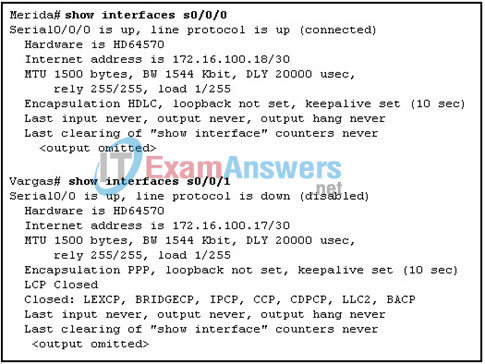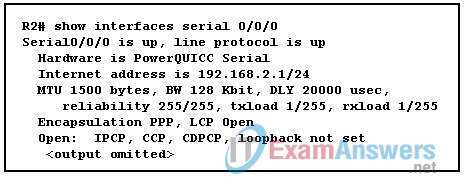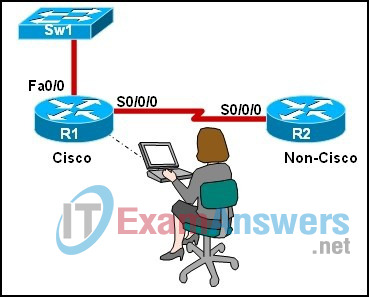1. Why are Network Control Protocols used in PPP?
- to establish and terminate data links
- to provide authentication capabilities to PPP
- to manage network congestion and to allow quality testing of the link
- to allow multiple Layer 3 protocols to operate over the same physical link
2. What is the data transmission rate for the DS0 standard?
- 44 kb/s
- 64 kb/s
- 1.544 Mb/s
- 44.736 Mb/s
3. In which two layers of the OSI model are key differences found between a LAN and a WAN. (Choose two.)
- Layer 1
- Layer 2
- Layer 3
- Layer 4
- Layer 6
- Layer 7
4. Which statement is true about the Cisco implementation of the HDLC protocol?
- It supports authentication.
- It has a universally compatible frame format.
- It is the default encapsulation for serial interfaces on Cisco routers.
- It does not support multiple protocols across a single link.
5. Refer to the exhibit. A network administrator has a connectivity problem between the serial interfaces of Merida and Vargas. What is the cause of the problem?

- Authentication is required on the serial link.
- The encapsulation is misconfigured.
- The IP addresses are on different subnets.
- The serial interface on Vargas is shutdown.
- The loopback interfaces on both routers are not configured.
6. Refer to the exhibit. What statement is true about the exhibited output?

- LCP is in the process of negotiating a link.
- LCP and NCP are waiting for CHAP authentication to complete.
- LCP negotiation has completed successfully, but NCP negotiation is in progress.
- LCP and NCP negotiation is complete, and the data link service is available to carry packets.
7. Which three statements are true regarding LCP? (Choose three.)
- It is responsible for negotiating link establishment.
- It negotiates options for Layer 3 protocols running over PPP.
- It uses MD5 encryption while negotiating link-establishment parameters.
- It terminates the link upon user request or the expiration of an inactivity timer.
- It can test the link to determine if link quality is sufficient to bring up the link.
- It monitors the link for congestion and dynamically adjusts the acceptable window size.
8. Why are Frame Relay paths referred to as virtual?
- Frame Relay PVCs are created and discarded on demand.
- The connections between PVC endpoints act like dialup circuits.
- There are no dedicated circuits to and from the Frame Relay carrier.
- The physical circuits inside the Frame Relay cloud do not contain exclusive links for a specific Frame Relay connection.
9. What best describes the use of a data-link connection identifier (DLCI)?
- an address identifying a virtual circuit
- a logical address identifying the DCE device
- an address identifying a Layer 3 service across a Frame Relay network
- a logical address identifying the physical interface between a router and a Frame Relay switch
10. What two services allow the router to dynamically map data link layer addresses to network layer addresses Frame Relay network? (Choose two.)
- ARP
- ICMP
- Proxy ARP
- Inverse ARP
- LMI status messages
11. Which three statements describe functions of the Point-to-Point Protocol with regards to the OSI model?(Choose three.)
- operates at all layers of the OSI model
- provides a mechanism to multiplex several network layer protocols
- can be configured on both synchronous and asynchronous serial interfaces
- uses Layer 3 of the OSI model to establish and maintain a session between devices
- uses the data link layer to configure such options as error detection and compression
- uses network control protocols to test and maintain connectivity between devices
12. At what physical location does the responsibility for a WAN connection change from the user to the service provider?
- demilitarized zone (DMZ)
- demarcation point
- local loop
- cloud
13. What does a Frame Relay switch use to inform the sender that there is congestion?
- FECN
- BECN
- DE
- FCS
14. Refer to the exhibit. What statement is true about the debug output?

- R2 is using PAP instead of CHAP.
- The routers have different CHAP passwords configured.
- The administrator performed a shutdown on the R2 PPP interface during negotiation.
- The Layer 3 protocol negotiation caused the connection failure.
15. Which two statements describe the function of time-division multiplexing? (Choose two.)
- Multiple data streams share one common channel.
- Conversations that require extra bandwidth receive any unused time slices.
- Time slots are utilized on a first-come, first-served basis.
- Time slots go unused if a sender has nothing to transmit.
- Priority can be dedicated to one data source.
16. When customers use credit cards to make purchases at a small business, a modem is heard dialing a telephone number to transfer the transaction data to the central office. What type of WAN serial connection is in use?
- leased line
- point-to-point
- circuit switched
- packet switched
17. Which best describes data communications equipment (DCE)?
- serves as data source and/or destination
- responsible for negotiating windowing and acknowledgements
- physical devices such as protocol translators and multiplexers
- equipment that forwards data and is responsible for the clocking signal
18. Permanent virtual circuits and switched virtual circuits are both part of which option for WAN connectivity?
- leased line
- cell switching
- packet switching
- circuit switching
19. Which field of a frame uses error detection mechanisms to verify that the frame is not damaged intransit?
- FCS
- MTU
- flag
- control
- protocol
20. What occurs in the encapsulation process as a data packet moves from a LAN across a WAN?
- The Layer 2 encapsulation changes to a format that is appropriate for the WAN technology.
- The Layer 3 encapsulation changes to a format that is appropriate for the WAN technology.
- Both Layer 2 and Layer 3 encapsulation change to a technology that is appropriate for the WAN.
- Both Layer 2 and Layer 3 encapsulation remain constant as the data packet travels throughout the network.
21. Refer to the exhibit. The network administrator is configuring R1 to connect to R2, which is a non-Cisco router. Which encapsulation method will need to be configured for communication to occur?

- HDLC
- HSSI
- ISDN
- IPCP
- PPP
22. A company is implementing dialup services for remote workers to connect to the local network. The company uses multiple Layer 3 protocols and requires authentication for security. Which protocol should be used for this remote access?
- LMI
- PPP
- HDLC
- Frame Relay
23. Which two options can LCP negotiate? (Choose two.)
- compression
- authentication
- dynamic flow control
- network layer address for IP
- connection-oriented or connectionless communication methods
24. What statement best describes cell switching?
- It uses a dedicated path between endpoints.
- It creates a permanent physical link between two points.
- It uses DLCIs to identify virtual circuits.
- It creates fixed-length packets that traverse virtual circuits.
